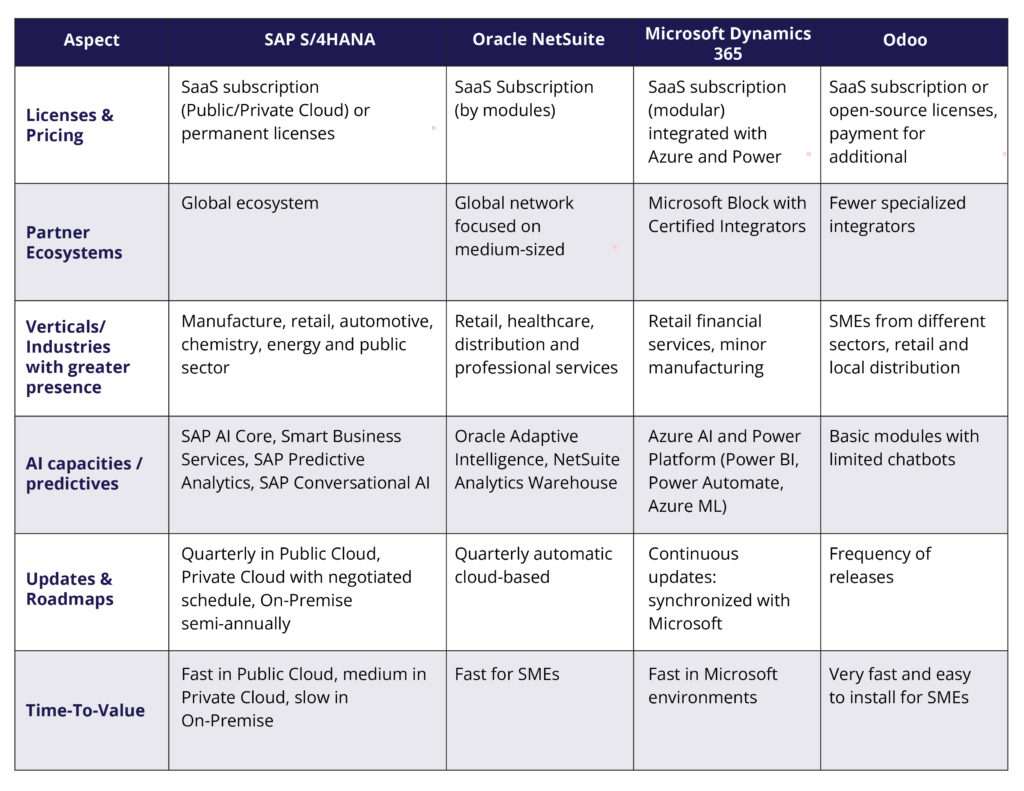Today’s business landscape is defined by growing competitiveness, a race toward digitalization, increased volatility, and the challenge of maintaining operational efficiency while adapting quickly to market changes. In this context, SAP S/4HANA ERP systems (Enterprise Resource Planning) emerge as a fundamental and indispensable tool.
Among the various ERPs on the market, SAP stands out as one of the best options, addressing three key areas directly and effectively:
Business Process Automation
Automating business processes enhances efficiency by eliminating human error and allowing resources to focus on higher-value tasks. In SAP, processes that can be reviewed and automated include the following areas: Finance, Logistics, Human Resources, Production, Procurement, and Sales.
Main advantages of process automation:
- Scalability without a significant cost increase: Organizations can handle a higher transaction volume without adding headcount.
- Traceability and regulatory compliance: Every transaction is recorded in real time, simplifying audits and the generation of regulatory reports.
Quantitative example:
A manufacturing company implemented S/4HANA Cloud with the FI-GL (Financial Accounting – General Ledger) and CO (Controlling) modules, cutting its monthly financial close from two weeks to one—a roughly 50% time reduction.
Intelligent Workflows
SAP’s ERP not only executes processes but continuously improves workflows by applying automation, artificial intelligence, and machine learning to anticipate issues and enhance decision-making. Key modules and services include:
- SAP AI Core
- Smart Business Service
- SAP Predictive Analytics
- SAP Conversational AI
Notable funcionalities:
- Inventory Management: SAP Predictive Analytics analyzes sales history and external variables to forecast demand. Basic intelligent replenishment flow:
- Daily collection of sales and stock data in SAP S/4HANA Public Cloud.
- Predictive model calculates next-period demand.
- If forecast exceeds minimum stock, Smart Business Service issues an alert.
- Automatic creation of a purchase order in SAP MM (Materials Management) sent to the supplier.
- Automatic receipt and registration of goods in SAP WM (Warehouse Management).
- Real-time stock updates.
- Accounts Payable: SAP AI Core detects unusual patterns to suggest automatic invoice reviews.
- Human Resources: SAP Conversational AI implements internal chatbots for payroll, absence, and training inquiries and Smart Business Service applies AI to analyze employee turnover patterns and suggest retention plans.
Real-Time Integration
A cornerstone of SAP ERP implementations is full real-time data availability, offering:
- Complete, transparent visibility: Instant access to KPIs across all areas.
- Efficient cross-department coordination: All departments share the same data and terminology.
- Connection with auxiliary systems (CRM, IoT, external platforms, e-commerce, etc.):
- Integration of supplier and customer data in procurement and sales.
- Synchronization of sensor and production-line data.
- Immediate stock updates.
Furthermore, SAP Business Technology Platform (SAP BTP) serves as an integration and innovation layer, enabling:
- Development of custom business functionalities without altering the core system.
- Connectivity with third-party solutions via APIs or event streams.
- Use of advanced services such as SAP Data Intelligence, SAP Analytics Cloud, and SAP HANA Cloud.
Deployment Options for SAP S/4HANA:
- S/4HANA Public Cloud: Ideal for companies seeking rapid time-to-value and minimal infrastructure management.
- S/4HANA Private Cloud: Recommended for mid-sized companies balancing flexibility with IT control.
- S/4HANA On-Premise: Designed for large enterprises with strict data regulations and internal infrastructure policies.
In all cases, SAP BTP underpins these services as the integration and innovation layer.
Scalability and Total Cost of Ownership (TCO)
Although SAP S/4HANA’s implementation cost may be higher upfront, a 5–7-year TCO analysis shows ROI through productivity gains and operational savings. Key TCO components include:
A comparative table highlights basic features of SAP S/4HANA versus Oracle NetSuite, Microsoft Dynamics 365, and Odoo.
- Licensing:
- SaaS (Public/Private Cloud): Periodic per-user or per-module fees, including basic support and automatic updates.
- On-Premise: Annual fixed licensing fees (per user or module) plus maintenance (around 20% of licensing cost).
- Implementation:
- Consulting services for system configuration, unit testing, data migration, and user training.
- Variable costs based on complexity (number of countries, integrations, legal requirements, etc.).
- Infrastructure
- Public Cloud: Managed by SAP or a cloud provider.
- Private Cloud/On-Premise: On-premises hardware, database licenses, power, and cooling, with renewal every 4–5 years.
- Maintenance and Support:
- SaaS: Included support and automatic updates.
- On-Premise/Private Cloud: Internal IT or partners handle updates under additional contracts.
- Training and Change Management:
- Planning and administering initial and ongoing user training.
- Change-management programs to drive user adoption.
- Savings and Payback:
- Improved operational efficiency.
- Reduced errors and labor costs.
- Enhanced decision-making visibility.
Comparison with competing ERPs

Conclusion
SAP S/4HANA Cloud (in any deployment mode) is more than just a data repository. It enables companies to:
- Slash financial-close times by up to 47% and cut accounting errors by 25%.
- Enhance customer service levels.
- Reduce average inventory by 25% and transportation costs by 20%.
- Anticipate demand and automate replenishment with predictive models.
- Achieve 100% regulatory compliance and avoid penalties.
In short, SAP S/4HANA, together with SAP BTP and a hybrid-cloud strategy, represents one of the most comprehensive, scalable, and future-proof solutions, delivering quantifiable, sustainable long-term ROI.





